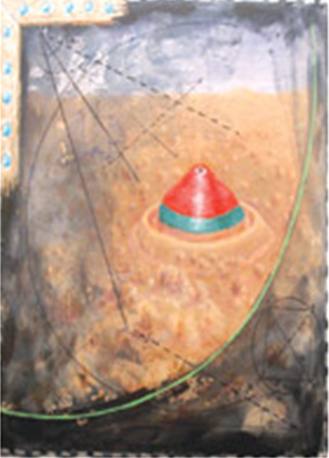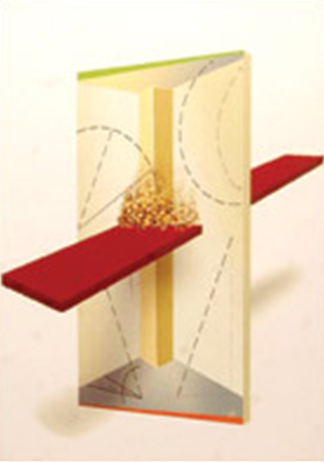Mansoor Saleem
This is a collection of articles archived for the excellence of their content. Readers will be able to edit existing articles and post new articles directly |
Mansoor Saleem
CAREER IN ART: Psychic fossils
Defying categorisation, Mansoor Saleem’s art freely accesses and modulates realism, abstraction and other relevant ‘isms’ to record his ‘epiphanies of the Geist’, writes Salwat Ali
It is not unusual to be baffled and bewildered when confronted with Mansoor Saleem’s art. His current exhibition of paintings, at Shakil Ismail Art Gallery, Karachi reiterates his ability to produce the extraordinary and the strange with amazing frankness.
Art inspired by unusual phenomena calls for extended viewer engagement and special understanding. Attributing the content of his painting to “psychic flashes” Saleem invites the viewer to experience the tangibility of the intangible. Defying categorisation, his art freely accesses and modulates realism, abstraction and other relevant isms to record his ‘epiphanies of the Geist’. Employing a visual vocabulary of familiar recognisable elements, often those of everyday use, he constructs the improbable and the unlikely.
Extra-terrestrial bodies on terrestrial terrain, cosmic atmospherics scribbled with mathematical equations and geometric graphics binding scattered body limbs are as common to his oeuvre as are inversions of rural landscape, urban interiors and exteriors. Removed from their natural environment, often liberated from the laws of weight and gravity, juxtaposed with disparate elements and purporting uncanny situations his paintings are entirely open to inquiry.
A half open leather bedroll, the kind used in train travels, is painted in detail perhaps symbolising a journey, but of another nature. In yet another odd composition a royal blue wall with gold motifs sports a triangular cavern sheltering tiny twin abodes. But it is the panaflex print on white canvas that best defines the status of his work. A teak brown horizontal plank is shown cutting through a vertical panel of wood to create two sides of a divide, the side visible to the viewer is painted as a three-dimensional corner of a room. A heap of dust/wood shavings cover the cutting edge of the plank as it slices through the panel and the corner walls are perked up with geometric graphics of semi circles and triangles. This image symbolises the divide between the known world and the unknown — a feature peculiar to Saleem’s art which professes a reality beyond reality.
Recourse to the esoteric in art is by no means a new phenomenon. Almost a thousand years ago individuals and movements concerned with some sort of personal, eccentric unorthodox, mystical or supernatural expression were already in existence. Christian artists from the 4th to the 16th century tried to depict the indescribable punishments of the sinners and the ecstasies of the blessed. Sporadic efforts at examining the super natural continued through the 18th century, most notably in William Blake’s mystic visions and Francisco Goya’s macabre and powerful nightmares displaying a blighted world.
As Romanticism and Symbolism grew and spread in the 19th century, visions of imagined worlds appeared in many forms in painting sculpture and architecture. Late 19th century explorations of the irrational and fantastic and the growing interest in naïve and primitive modes of expression culminated in World War 1 in the form of Dada, which in the mid 1920’s developed into Surrealism. The Dadaists felt that reason and logic had led to the disaster of world war, and that the only way to salvation was through political anarchy, the natural emotions, the intuitive and the irrational. In the search for new content it was the metaphysical painters like De Chirico, Magritte and Carra who took the first deliberate step to make real and comprehensible the improbable and the illusory, by juxtaposing them with normal everyday experience.
Saleem’s deconstruction is also executed with the vocabulary of the ordinary and the mundane but his expression is not entirely imaginary — the intuitive images are recordings of psychic flashes. The artist claims that he has moments of sudden realisations which he records instantly in hastily scribbled notes — these then become the basis of his paintings. The ‘kayfiyat’ (feelings) have no time constraints and he is often compelled to document them even in the middle of the night — such is their intensity. Some paintings on display at the gallery did have faint scribbled text, peculiar doodles and cursory ink sketches that could well be these initial messages.
An art practitioner since the 1970’s Saleem completed his formal art training from the Central Institute of Arts and Crafts in 1983 followed by a Masters degree in History and specialisation in archeology, from the Karachi University. Terming his ‘kayfiyat’ “psychic fossils”, Saleem likens them to archaeological fossils whose readings yield secrets about the planet earth — similarly he feels his flashes need to be read and deciphered.
Exhibiting irrational art consistently through eight solo shows and scores of group participations since the 1970’s he was indeed ahead of his times for it is only now in the liberal art climate of today that the bizarre and the awkward is enjoying common currency and validation.
The visual history of the metaphysical and the irrational is well documented in the west. In the east within an amalgam of Asian spiritual ideologies its manifestation is diverse and erratic. There is no consistent tabulation of this phenomenon in our art either inspite of the fact that several strands of the metaphysical experience are purported by our artists. Artist Tassadaq Sohail’s pygmy people inhabit an imaginary underworld, Mussarat Mirza and Meher Afroz explore the Sufi trail in their art one creates a cerebral dialogue while the other emotes from the heart; Noorjehan Bilgrami’s transition towards the unknown is influenced by Zen aesthetics and Riffat Alvi envisages the state of ‘fanaa’ in her latest work.
As more and more artists paint visions of imagined worlds Saleem’s request to open debate on this issue is timely and necessary. This phenomenon needs to be categorised and documented for its true worth.
The exhibition will continue till May 18, 2008.
Attributing the content of his painting to “psychic flashes” Saleem invites the viewer to experience the tangibility of the intangible

